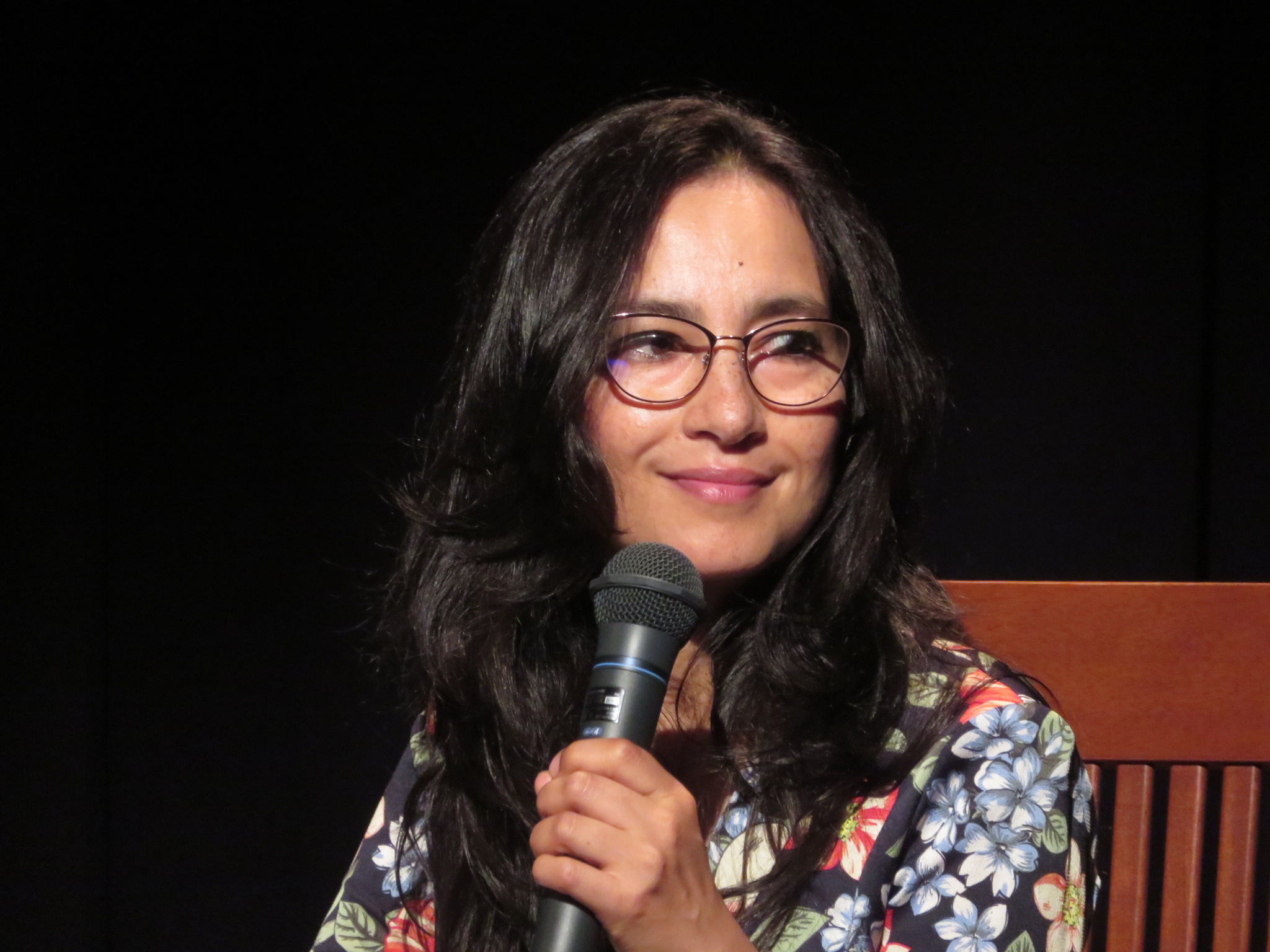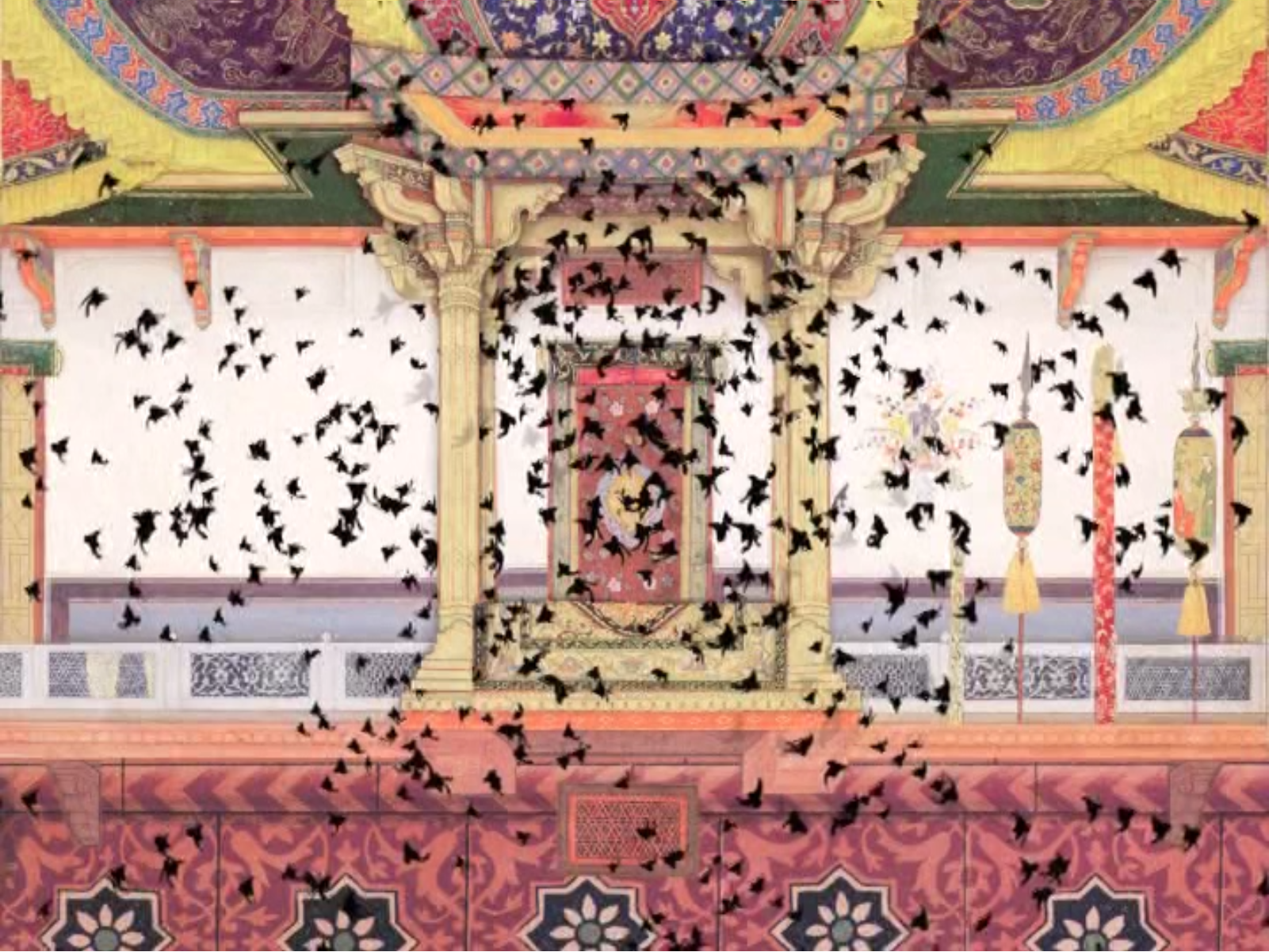Shahzia Sikander
From the Revolution of Miniature Tradition to Contemporary Art
- Name
- Shahzia Sikander
- Media
- Painting, Sculpture, Installation, Film/video
- Region
- Pakistan
- Year of Birth
- 1969
- Place of Birth
- Lahore, Pakistan
- Place of Residence
- New York
- External Link
- Link to Art Terms
-
- Link to Regions
-

Plate of artwork

Parallax
Digital animation with sound
15 min 25 sec
2013
Collection of artist
Installation for the commemoration of the 32th Fukuoka Prize (Arts and Culture Prize) at Artist Café Fukuoka (former Maizuru Junior High School), 2022, organized by the Fukuoka City and Fukuoka City International Foundation, cooperated by Fukuoka Asian Art Museum.
Photograph ©Nagano Satoshi


Sikander is a revolutionary artist in the miniature painting which has been created for hundreds of years in Indian Subcontinent (present India and Pakistan). During the 1980s when the miniature was deemed no more than souvenir for tourists without any creativity, she attempted experiments in representing the narrative including her autobiography and social criticism as well as formal and spatial innovations based on traditional technique of miniature she mastered at National College of Art in Lahore. After accomplishing her successful revival of the miniature as internationally acclaimed contemporary art, “neo miniature” is established as a significant genre of Pakistani contemporary art today. Fukuoka Asian Art Museum featured such works in the show titled Contemporary Miniature Paintings from Pakistan (2004-5).
The Scroll (1989-91) from her early years in Lahore, of unusually large size with 178cm in width as a miniature, a woman reminiscent of the artist repeatedly appearing as the iji dozu (the technique of depicting different time period in the same picture), juxtaposes different spaces of a house. The work not only shows the artist’s experiment on representing space that is boldly unconventional and distinct from Western tradition but also includes a foregrounding of women in the contemporary society, a theme which developed in her later works.
After Sikander moved to the U.S. in 1993, her challenge developed even more overwhelming in the juxtaposition of alien subjects, fragmentation of images, transformation of pictorial frames, along with political subjects including a critique on racism and contemporary Imperialism, as well as feminism, thereby continued challenging the traditions and ideologies. Especially her attempts to deconstruct the prejudice and violence against “the others,” people from Islamic world, and stereotyped images of “women oppressed in Islamic communities,” became her major subjects. Many Faces or The Resurgence of Islam (1997–99)has a strong political overtones, dealing with issues surrounding Islamic world which had been shaking the world, as it was aimed for a reproduction in a magazine. Yet, she showed her stuff in the techniques to create the turbulence, rather than harmony, which cannot be reduced or translated to any messages. The bullet-hole-like dots to disturb spatial consistency, the autonomic movement of decorative motifs or trivial details which usually kept marginalized, incomplete shapes like trial sketches outside the frames, and weird images of monstrous women are some of examples.
These hand painted works already had the experiments of ‘cut and paste’ and ‘layering’ commonly used to process images in computer, so it was a natural development for Sikander to create animation in digital media. Another development of Sikander’s miniatures is large installation works with semi-transparent paper, amplifying the potential oftransgression of frames and complicated depth of spaces inherent in paintings in the minimum size. These works attracted international attention resulting in exhibitions at art museums in Western cities, participation in international exhibitions, and commission of public art, after her participation in the Whitney Biennale, 1997.
Decoding the animation work 1: SpiNN
SpiNN, her earliest animation work based on digitization of her on miniature , conveys a deep and complicated abyss of contemporary world, which does not allow us the recurrence to tradition or easy decoding, albeit the absence of any narratives.
The video opens with a scene of durbar hall originally used for the court or meeting supervised by kings or maharajas of Mughal, but the rulers are absent in the center who are supposed to dominate the scene, which is instead occupied by numerous nude women. They are gopis, milkmaids and passionate admirers of Krishna, Hindi god. Soon their hairdos separated from bodies rotate like a flock of birds or swarms of insects, to invade the space. The hairdos become a black mass and followed by a silhouette of a winged angel. They are replaced by a group of angels flying with fluttering scarfs, over a landscape of a vast natural field. Other angels in Western iconography appear but soon disappear. Next come a woman in sari and European Venus[1] in an oval shape which seem to represent a unity of Eastern and Western cultures, or the solidarity of women, blessed by the angels. In the last scene, the beautiful landscape remains, but disturbed by demons including one brandishing a hammer.
The development of images as such enables feminist reading: women in collective and solidarity occupy the space of men (king, Maharaja, Krishna) to deconstruct it, and form a community for the liberated in the beautiful nature. However, the black mass which disturb the architectural structure with rotation and intrude to the space look ominous like a flock of crows or combats, implying the women’s victory is no more than a fantasy.
The strange title, SpiNN,[2] has complicated layers of pun by the artist. A common use of “spin” is for visual spinning of images such as hairdos, but it also means biased information delivered by politicians or corporates in press conferences etc. as “spin propaganda.” The two Ns remind us of CNN, one of major TV stations in U.S. It is difficult to read political connotations in this work but the title could have reflected the situation in which biased information and attack to Muslims in American opinions after the terrorist attack in September 11, 2001.
Decoding the animation work -2: Parallax
Parallax. Sikander’s work exhibited when Sikander was awarded the 32nd Fukuoka Prize (Arts and Culture Prize), is created through the artist’s residency in United Arab Emirates (UAE) in 2011–12. She researched the cultural hybridity and historical layers of the region facing the Strait of Hormuz and this resulting work was presented at Sharjah Biennale in UAE, 2013.
The title means a different view of objects seen from different viewpoints. The animation starts with a flock of gopi’s hairdos taken from miniatures, but the enlarged flow of red and blue paints and semi-abstract forms difficult to identify are dominant, proving the artist’s new development away from traditional miniatures. In the horizontally long screen, framing moves vertically and horizontally; both the forms and backgrounds rotate, which shake viewers’ vision. In particular, this work focuses on extreme enlargement and reduction in scale as another kind of “parallax.”
Reflecting the artist’s experience in the state with 7th largest oil production in the world, oil-like black liquid springing out and oil wells reminiscent of white Christmas trees appear. However, the Christmas trees break into pieces with large sound of explosion and gunshots, so as to represent the history of frequent wars in this region. The small flying forms, when enlarged, are found as arms with clenched fists as those from multi-armed Hindu deities, which may refer to the unsuccessful struggles in the region. Next, the whole screen is occupied with two figures connected to their lower bodies. The artist explains the image is inspired by a Pakistani caretaker of an old cinema remaining in Sharjah. One of the heads is a skull to represent the series of life and death.
In the last scene with the gopi’s hairdos flying in six circles (or spheres), poems written by three poets in Sharjah the artist commissioned are recited. The poems are about the local and personal history, anxiety and separation of lovers, spiritual journey, etc., read in Arabic, which fascinate viewers with sound rather than meaning. The work ends with the disappearance of circles with each different movement, leaving audience unsolved mystery.
As the title indicates, the extremely wide screen forces viewers to change their standpoints due to the difficulty to get the whole view. It also means the impossibility to hold a fixed and privileged vantage point in regions where diversity of ethnicity, languages, and cultures left multi-layered history; the people who live there must keep changing their locations to measure difference of views from those of the others—thus PARALLAX is an inescapable experience which all who live this globalizing world have to face.
Challenges with the Public Art
In Sikander’s recent project of the art in public space, “Havah…to breathe, air, life” exhibition in 2023, she presented Witness in the Madison Square Garden, and NOW in the rooftop of the New York City Supreme Court. These two sculptures, with spiral horns, symbols of strength and wisdom[3], are taken from an image of a woman in Sikander’s miniature Pleasure Pillars, 2001. Witness hovers from the ground with her hoop skirt and thus mobile at her will still with her own root. NOW is installed with other statues representing legitimizers—all male—to announce women have equal right to deal with the law and justice as men. However, when Witness was presented at the University of Houston after New York, the conservative communities against the artificial abortion furiously blamed the work as “satanic,” and it was eventually beheaded by an unidentified protester. [4] Yet, Sikander continued to exhibit the sculpture without repairing or removing, as “a testament to the hatred and division that permeate our society.” [5]
Now (as of April 2025) in the U.S., the government supported by the conservative communities is abolishing policies to respect DEI (diversity, equity, inclusion) which have been established by citizen’s movements, excluding the immigrants and sexual minorities. It is exactly this situation where Sikander’s dauntless questionings becomes all the more significant.
[1] The image of Indian and European women appears in Sikander’s miniature Sly Offering (2001).
[2] Sikander’s works with the same title include three miniatures with images which do not appear in the animation work.
[3] Carlie Porterfield, “Shahzia Sikander says she will not fix statue that was beheaded in Houston,” The Art Newspaper, August 1, 2024.
[4] The work drew criticism from the anti-abortion Christian group, not only because of the figure’s a pair of braded horns which look “satanic”in the European Christian culture, but also it had an intricate lace collar worn by the late Supreme Court justice Ruth Bader Ginsburg who acknowledged the right of abortion. Karen K. Ho “Shahzia Sikander Sculpture Beheaded at the University of Houston,”ARTnews, July 9, 2024.
[5] Ibid., The Art Newspaper; ‘Show the violated work’: Artist requests beheaded sculpture remains on view,” CNN website, July 12, 2024
「福岡アジア美術館での「パキスタンの現代細密画」展(2004~5年)で紹介されたように、